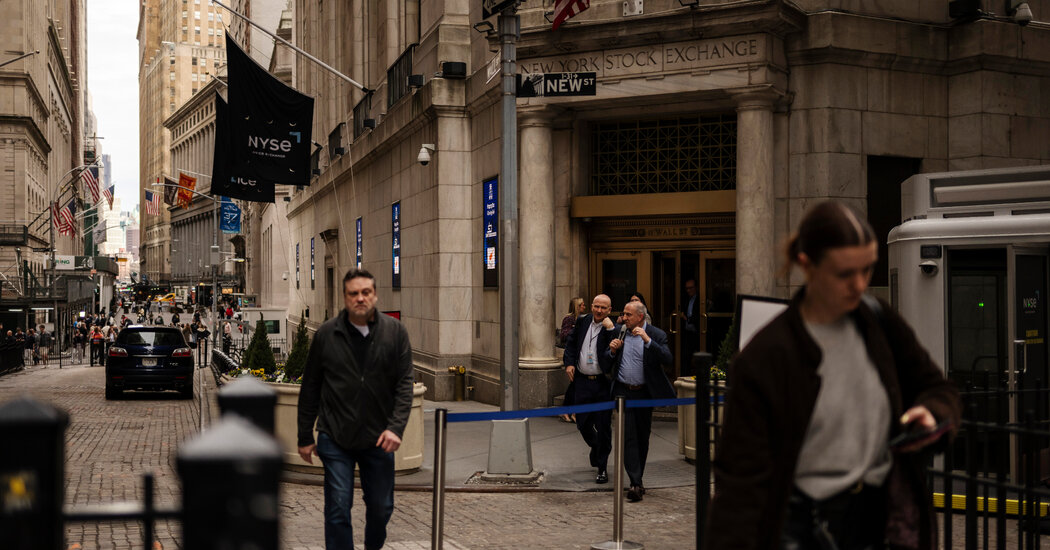Chaos and uncertainty after Trump’s tariff rollout
Wall Street’s elite grappled with anger, anxiety, frustration and fear over the weekend in response to President Trump’s announcement of sweeping new tariffs, which top Trump aides raced to defend in various news media appearances. Some of his advisers said that they had already heard from foreign nations seeking to negotiate a deal on trade.
Financial markets were hit hard by another wave of selling at the start of trading in Asia this morning, with investors and economists grappling with rising odds of a severe economic downturn. Stocks in Japan plunged over 8 percent, while South Korea’s market tumbled about 5 percent. The price of Bitcoin has plunged 10 percent since the tariffs were announced, dropping below $78,000 last night, and U.S. oil prices fell by 15 percent.
Yet Trump’s top economic advisers dismissed the turmoil, insisting that the trade war would ultimately improve America’s economic fortunes. Speaking to reporters yesterday, Trump said that he would not reverse them until the trade deficits that the U.S. runs with China, the E.U. and other nations disappeared. “Unless we solve that problem,” he said, “I’m not going to make a deal.”
Like Brexit, Trump’s tariffs struck a hammer blow at the established order, Mark Landler, our London bureau chief, writes in an analysis. But, also, as in Brexit, the ultimate ramifications are unsettled: Trump could yet reverse himself. And free trade may remain so popular that the rest of the world finds a way to keep the system going, even without the U.S., its central player.
What’s next: The tariff announcement on Friday has plunged corporate America into chaos. We asked economists, investment researchers and other experts to help make sense of what lies ahead.
More on the Trump administration
The accounts could not be independently confirmed, but the details matched a video obtained and verified by The Times. They also appeared to support the U.N.’s accusations that Israeli troops had killed the aid workers, discarded their bodies and destroyed their vehicles.
On Saturday, after the video surfaced, the Israeli military said that its initial accounts of its troops’ involvement in the shooting had been partially “mistaken.” Here’s what else we know.
What’s next: After the blatant inconsistencies in the Israeli account were revealed, the military seemed to move more quickly than usual to address the issue. However, an official denied reports that some of the bodies were found bound and had been shot at close range. Separately, Prime Minister Benjamin Netanyahu will this morning meet with President Trump at the White House.
Go deeper: The Times examined an Israel strike that destroyed an evacuated displacement camp and killed a 4-year-old child.
Israel: Immigration officials in Tel Aviv denied entry to two British lawmakers and sent them back to London.
There may be unsecured chemical weapons in Syria
More than 100 chemical weapons sites are suspected to remain in Syria after the fall of Bashar al-Assad, according to the world’s leading chemical weapons watchdog. The number is far higher than any previous estimate.
The watchdog organization is seeking to assess what remains of the deadly stockpiles, and how much of them are secure. The chemicals, including sarin, mustard gas and chlorine gas, represent a major test for Syria’s caretaker government. Last month, the foreign minister said the government would destroy any weapons that remain, but it has yet to appoint an ambassador to the watchdog, a key first step.
For decades, the father of a childhood friend had asked Taffy Brodesser-Akner, a reporter for The New York Times Magazine, to tell his story of surviving the Holocaust. She refused — until a piece of news changed her mind. Read the story she said she wouldn’t write.
Lives lived: Theodore E. McCarrick, a high-ranking cardinal who was accused of abuse and was stripped of his priesthood by Pope Francis, died at 94.
CONVERSATION STARTERS
ARTS AND IDEAS
Meet your new robot butler
A.I. is driving cars, writing essays and coding. Now, humanoids — machines built to resemble humans — are getting ready to move in and help with daily chores. The engineer Bernt Børnich hopes to put his version, called Neo, in more than 100 homes by the end of the year.
Our tech reporter Cade Metz visited Børnich’s home, where he shook hands with a prototype. The humanoid then went to the refrigerator for a bottle of water, but it needed a hand from a human technician to do so. “Robots are still learning to navigate the world on their own,” Cade writes. “And they need a lot of help doing it. At least, for now.” Read more here.
